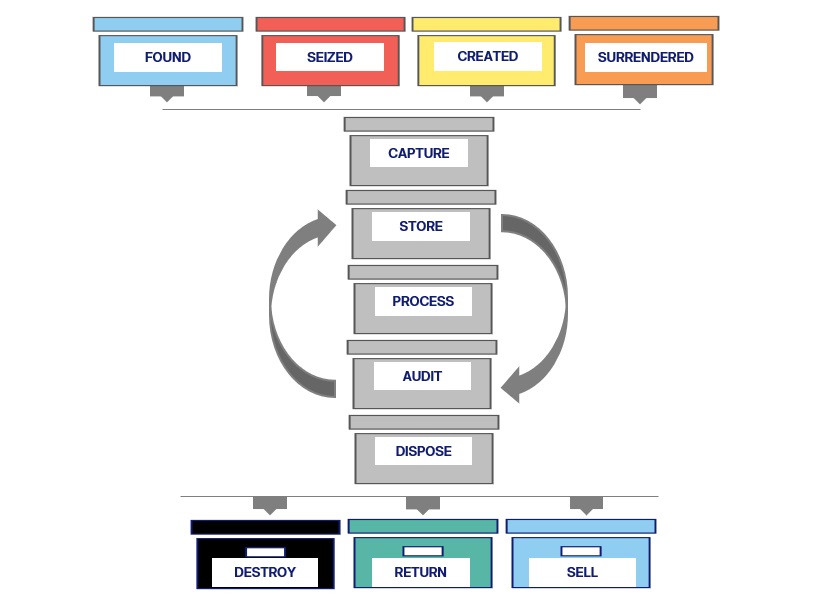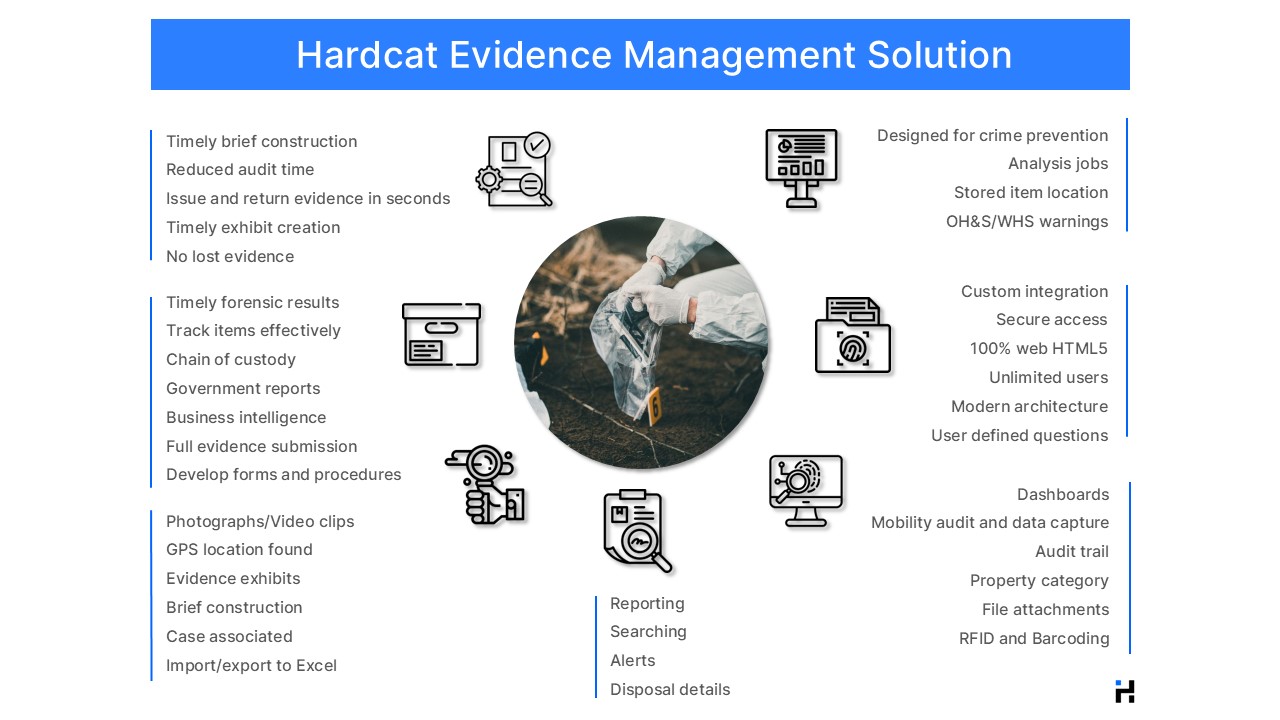Evidence tracking for law enforcement is integral to successful prosecutions. We need to ensure each exhibit item’s integrity, security, and that processes comply with legal and regulatory requirements. Recording every touch point on forensic exhibits and seized property, our software is used by law enforcement, forensic labs, legal teams, and other groups that handle lots of evidence. Digital evidence tracking also assists organisations in managing the collection and proper storage of items.
Components of effective exhibit management
- Identification of items through tagging using technologies like barcoding, QR codes, and RFID tags.
- Accurate evidence logging ensures seized items are properly registered and recorded as accurate data helps establish a correct chain of custody, which is essential for the exhibits to be accepted in a court of law.
- Location tracking keeps a record of when items are removed from and returned to storage, ensuring the exhibits remain secure, and its integrity is preserved.
- User-friendliness is also crucial to ensure that personnel across different levels of technical proficiency can effectively interact with the system.
- Scalability to accommodate growing evidence volumes, robust security features to safeguard against unauthorised access, and the system’s adaptability to evolving technological landscapes are paramount.
What is evidence management software?
Evidence management software eliminates the need for paper-based methods. These systems provide a faster, better way to handle evidence, streamlining evidence tracking, logging, verification, registration and providing assurance. Because digitisation removes the need to maintain manual evidence logs or briefs. Joining a full chain of custody for every entry and interaction with that exhibit item record.
The purpose of an evidence tracking system is to ensure efficient management of evidence collected. This includes maintaining proper chain of custody, safe and secure storage of seized/gathered evidence, and timely disposal in accordance with the law.
Additionally, they also include documentation processes, issuance and receipt of items, and disposal procedures. The goal is to streamline and automate the management of evidence, improve tracking and retrieval, and enhance security and accountability.
Law Enforcement collect a vast range of property in the course of their duties, encompassing all lost and found, created, surrendered, and seized property that comes into their possession. An exhibit is any property in police possession that may be tendered in court as evidence. Victoria Police records show approximately 470 000 items in police possession, stored at more than 200 locations. Police Management of Property and Exhibits
What is the evidence chain of custody?
Without a record of who handled the evidence, its authenticity is at risk. So is its admissibility in court. Evidence management software solves this problem. It tracks each item’s journey, from the moment it’s collected. Log every officer, technician, and handler with time stamps. This ensures accountability at every step.
Every piece of evidence must be traceable to its origin. It must not be altered or tampered with. This method aims to guarantee the evidence’s integrity. It must remain pure as it moves through various stages.
Imagine a courtroom where a crucial piece of evidence determines the outcome of a high-stakes trial. The integrity of this evidence is paramount, not only to the case but to the entire justice system. This is where the concept of the “chain of custody” comes into play. It’s a legal lifeline that maintains the purity and integrity of evidence from the crime scene all the way to the courtroom.
The chain of custody is not just a series of steps followed by law enforcement; it’s a critical, procedural safeguard that ensures all physical and digital evidence presented in court remains uncontaminated and unchanged. By documenting every move, touch, and transition of the evidence, the justice system can provide a fair trial, essential for preventing wrongful convictions and ensuring that justice prevails. The Critical Role of Evidence Chain of Custody in Justice

Ensure the integrity of exhibits
The judicial system relies upon credible evidence that can withstand scrutiny when contested. This certainty and the integrity of such evidence come from the efficient management and tracking of the exhibit’s chain of custody. The goal is to automate evidence management. It should improve tracking, retrieval, security, and accountability. To ensure evidence is intact, various processes and tools are used. These include:
Chain of Custody
From the initial transaction of an officer registering exhibits and seized items, all associated transactions are recorded to help establish the chain of custody. This is essential for the evidence to be accepted in a court of law. The detailed log shows who collected, handled, transferred, or analysed the item during the investigation.
Exhibits Movement
Keeping a record of when items are removed from and returned to the storage facility ensures that the evidence remains secure and its integrity is preserved.
Safety and Security
We must ensure the safety of seized articles. It is vital to keep evidence intact. Evidence management software will ensure limits on access. It will also require regular monitoring and audits. This will safeguard the confiscated items, minimising the risk of tampering, theft, or damage to the evidence. This will preserve its integrity. Also, explosives, biohazard items, and other high-risk evidence are flagged in the system to protect those handling the exhibits.
Benefits of Hardcat evidence tracker software
Using a dedicated evidence management solution, not just spreadsheets, has benefits. It improves accuracy, speeds up data entry, and boosts security. It also allows for quick, meaningful reports. Basic data, such as the date, time, and location of evidence found and the identity of the officer collecting it, can be reported with any further transactions on that record. This initial record serves as a reference point for all future handling of the evidence. It improves tampering risk and evidence loss management. It meets compliance requirements through robust chain of custody processes and reporting. Some of the benefits are:
Search and Audit Capabilities
Powerful search capabilities that allow the user to slice and dice the data and quickly find the evidence item they are looking for. With the use of smartphones and tablets, audits of the evidence stored can be completed in a matter of hours or minutes rather than days.
Reporting on Events
Supply reports on demand or automatically upon the occurrence of given events or a consolidated view of all property and evidence under the control of the enterprise. Station-by-station reporting is also available. Reporting will highlight stations that have not been audited in the correct period. The inbuilt reporter has the flexibility and power to create and publish any required reports, such as:
- Management
- Operational
- Chain of custody
- Detailed audit trails
- History and briefs
Track Every Interaction
Transfers and data access mean complete visibility at every stage of exhibit processing and that the chain of custody is fully transparent. The risk of evidence tampering is minimised through enforced accountability at every stage. Changes are recorded in a chain of custody log, ensuring accountability and the current location of the item being accurately reflected. This is key to ensuring items can be easily found when required.
Finding Stored Evidence
No matter where your evidence is being stored—inside an evidence room, in an area outside, or in a container—don’t spend hours looking for a particular piece of evidence. Our RFID mobility application acts like a Geiger counter, getting louder as you get closer to the evidence that you are looking for.
Exhibit Storage
Ensure property and evidence are stored for the required time limit. Regulations may stipulate the retention of evidence of unsolved serious crimes for a minimum period, such as 50 years. Police must package and store property correctly and appropriately to maintain its condition at the time of seizure and to preserve its evidentiary value. Disposing of property as soon as it is lawfully and practically possible helps free storage capacity, avoiding keeping seized items for long periods unnecessarily. This increases available storage capacity and reduces resources and time to manage and audit, saving time and money.
Disposal Procedures
Simplify the management of stored property based on its evidentiary value by ensuring effective procedures. Therefore, avoiding additional storage and administration costs, which occur in manual systems. Exhibit disposals via destruction, sale at public auction, or return to owner with a complete workflow to manage authorisation, transport, and witnesses.
Occupational Health and Safety Risks
The safety and security of seized items are of utmost importance in maintaining the integrity of evidence. Ensure access limits, regular monitoring, and audits are in place to safeguard the confiscated items. Implementing these measures reduces the risk of tampering, theft, or damage to exhibits thereby preserving integrity. Explosives, biohazard items, and other high-risk evidence are clearly identified in the system to protect those handling the exhibits.
Mobility Apps
Mobile apps on iOS and Android let field workers access processes anywhere. They don’t need to be tied to a desktop PC. Moreover, you can deploy on specialist, ruggedised devices with built-in hardware for barcode and RFID tag scanning and GPS tracking. Allowing users to capture all manner of video, images, audio, and documents related to exhibits.

Conclusion
Hardcat evidence management software is transforming the way law enforcement agencies, legal teams, and government bodies handle exhibits. Enhance accountability with greater efficiency and improved security. Record and track every interaction with investigative intelligence in real time. Leverage Hardcat for seamless, best-practice electronic information management. Key to maintaining the trust and integrity of investigations.


